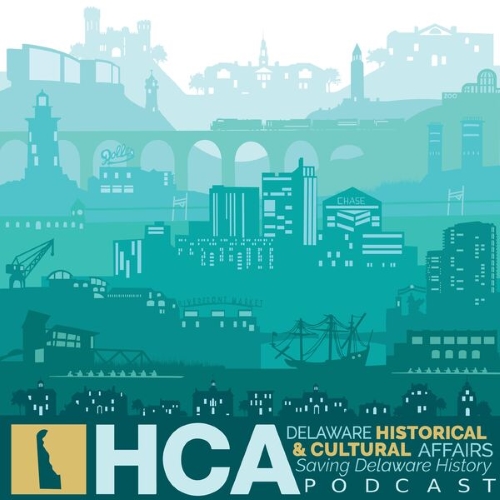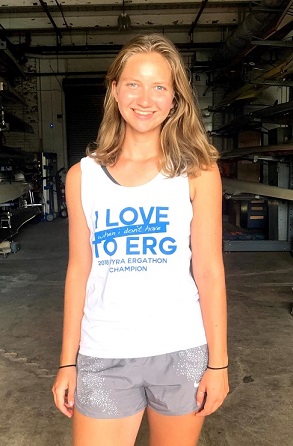Welcome to the Saving Delaware History Podcast!
By Madeline Messer, producer and host of the Saving Delaware History Podcast
“I’d like to welcome you to the Saving Delaware History Podcast.”
Those are the words I spoke at the start of each of the episodes in this series that began when the Delaware Division of Historical and Cultural Affairs decided to increase its youth outreach by launching a history-focused podcast. This is where I came in: I was initially tagging along on an interview that News Journal reporter Maddy Lauria was conducting with division historian Dan Citron, archaeologist Paul Nasca and director Tim Slavin at their new Center for Material Culture building in Dover.
After a tour of the facilities, and between interviews, Mr. Slavin and I discussed the division’s mission and how the agency could increase youth outreach and engagement. Ms. Lauria kindly offered to connect us over email so we could continue our discussion and, as we mulled over the possibilities, we determined a podcast was the most useful and practical of the ideas. By October 2020, we had set up an initial contract and I began coordinating with the division’s social-media lead Desiree May to brainstorm ideas and start orchestrating from there.
In the very beginning, my learning curve was steep. I discovered how difficult it was to establish an easy rapport with strangers online in less than an hour, and realized I had audio editing skills nowhere near the professional level. And, most mortifyingly of all, I had to listen to my own voice in the recordings! Quickly though, I realized the benefit of preparing a few questions with my guests to offer a rough roadmap of the episode and assuage discomfort with the virtual medium. And fortunately, some friends of mine offered to tutor me in useful editing techniques.
Within two weeks, the podcast was up, running and had a small following. In those first few months, I focused exclusively on the sites owned and operated by the division: The Old State House, New Castle Court House Museum, John Dickinson Plantation, Buena Vista Conference Center and the Johnson Victrola Museum. Then, with the start of the new year, our content expanded to include all employees, offices, partners and functions of the agency.
Among the most interesting topics we covered were the archaeological discoveries at Avery’s Rest. This was the very same subject Ms. Lauria had written about over the summer. For that, as for all subjects, I began by researching what this subject revealed about Delaware history, especially as it related to the division. While investigating, I usually found contact information for a potential interview, necessarily someone more knowledgeable about the subject than me and willing to discuss it in further detail. In the case of Avery’s Rest, this included anthropologists from the Smithsonian Institution, professional archaeologists and a doctoral student at the University of Pennsylvania.
Upon making contact, we brainstormed questions that fully and properly explained the topic while engaging the everyday listener. For the episode “Avery’s Rest: An Introduction,” the first one on the subject, questions began with how the initial discovery came about and gradually shifted the conversation to the longest-lasting legacy of the burial site. Once the questions were agreed upon, we set up a time to talk and record the raw audio for the podcast episode. On this unedited recording were our introductions, discussion about direction of the episode, various tangents and interruptions like dogs or computer updates. Really, the goal of the call was just to get as much content as possible.
Later, I took the audio file and spend a few hours editing it, making sure the ideas made sense and were in the right order, trimming out offhand comments, removing any background noise, normalizing the sound and adding the intro music. For every half hour of the original talk, I’d spend about an hour and a half editing it to produce about 25 minutes of the final episode. At times, I also moved some of the question-and-answer pairs around to make sure the general direction of the episode expanded logically.
Then came the simple and rewarding upload and publication of the file to the podcast hosting website. From there, segments were made available within 24 hours on the more popular podcast hosts such as Spotify, Apple and Google Podcasts where they can still be found today. All in all, each episode took about seven to eight hours to complete.
The production of the podcast series only seems possible when considering that my school year was entirely virtual. In my senior year at the Charter School of Wilmington, class ended by noon, leaving plenty of time for research, interviews and editing in the afternoons. For the many tragedies and inconveniences of quarantine, this job was undoubtedly one benefit. In no other year could I have taken a full course load, applied for college, run virtual clubs, volunteered, rowed competitively and managed a podcast for the State. These, among other accomplishments, helped me matriculate at Franklin and Marshall College, where I am pursuing environmental studies with a focus on environmental justice.
As I move out and away from home, I am glad to have improved my professional communication and research skills. Most importantly, I am grateful to have gained confidence in my own research and questions, and to have practiced meeting and befriending strangers, even virtually. As I move forward, I know I can apply these abilities to aid my future work promoting environmental conscientiousness and responsibility.
Madeline Messer is currently attending Franklin and Marshall College in Lancaster, Pennsylvania where she is majoring in environmental studies with a focus on environmental justice. She helped to create, and managed, the Saving Delaware History Podcast as a senior at the Charter School of Wilmington (Delaware) during the 2020–2021 school year.




